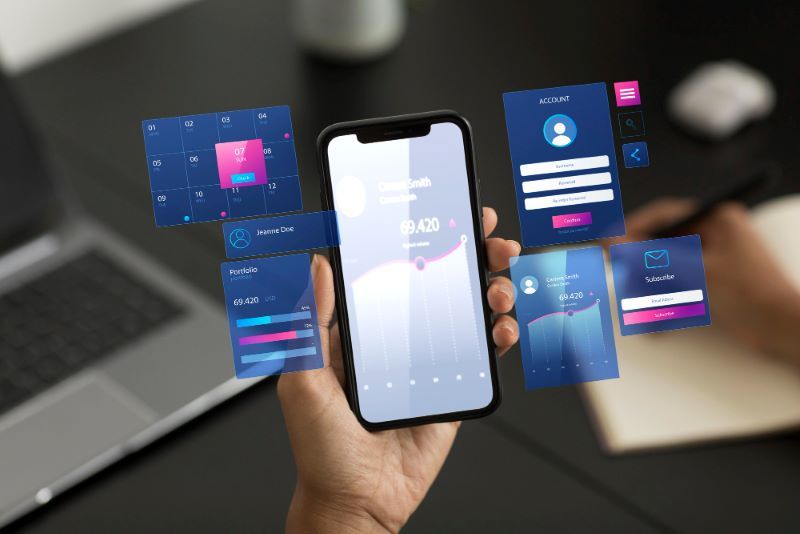Introduction to Responsive Design
In the digital era, where devices of all shapes and sizes dominate our everyday interactions. Ensuring that user experiences are seamless across various platforms has become crucial. Responsive UI/UX design is a methodology that addresses this need by making web and application interfaces adaptable to different screen sizes and orientations. This approach ensures that content is presented optimally, regardless of whether it’s viewed on a smartphone, tablet, or desktop monitor.
Understanding the Basics of Responsive Design
Responsive design is rooted in the principle that a single website or application should be capable of having its layout and elements adjusted based on the device’s screen size, resolution, and orientation. This concept was popularized by Ethan Marcotte in 2010, and how web development is approached was fundamentally transformed by it. At its core, responsive design employs fluid grids, flexible images, and media queries to create a cohesive and functional user experience.
Fluid Grids: The Foundation of Responsive Layouts
The essence of responsive design lies in the use of fluid grids. Unlike fixed-width layouts that rely on absolute measurements, fluid grids use relative units such as percentages to define the dimensions of elements. This allows the layout to adapt dynamically to different screen sizes. For example, instead of setting a container’s width to 800 pixels, a fluid grid would use a percentage, like 80%, ensuring that the container scales proportionally to the screen size.
Flexible Images and Media
Flexible images and media are critical components of responsive design. Traditional fixed-size images can become problematic on varying devices, either appearing too large or too small. To address this, responsive design employs techniques such as CSS media queries and the max-width property. By setting the maximum width of images to 100% of their container. They scale appropriately without distorting or overflowing. Additionally, responsive design often utilizes techniques like the srcset attribute for images, allowing browsers to select the most appropriate image size based on the device’s resolution and screen size.
Media Queries: Tailoring Experiences for Different Devices
Media queries are a fundamental tool in responsive design. Enabling designers to apply different styles based on specific conditions such as screen width, height, or device orientation. By incorporating media queries into CSS, designers can create breakpoints—specific screen widths where the design adapts to accommodate different layouts. For instance, a design might feature a multi-column layout on desktops but switch to a single-column layout on smartphones to ensure readability and usability.
Mobile-First Design: A Strategic Approach
A mobile-first design strategy emphasizes designing for the smallest screen size first before progressively enhancing the experience for larger screens. This approach aligns with the principle that mobile devices often have more constraints compared to desktops, such as limited screen space and slower internet connections. By starting with a mobile design, designers ensure that the core functionality and content are accessible and optimized for mobile users. From there, enhancements and additional features can be added for larger screens. Ensuring a consistent and effective experience across devices.
The Role of User Experience (UX) in Responsive Design
Responsive design is not solely about adapting layouts; it also involves enhancing the overall user experience (UX). UX design focuses on understanding user needs, behaviors, and interactions to create interfaces that are intuitive and satisfying. In a responsive design context, UX considerations include optimizing touch interactions for mobile devices. Ensuring that navigation is accessible and easy to use on all screen sizes, and maintaining performance and load times across different devices.
Performance Optimization: Ensuring Speed Across Devices
Performance is a critical aspect of responsive design, as users expect fast and smooth experiences regardless of their device. Performance optimization techniques include minimizing HTTP requests, optimizing images and media for different screen sizes, and leveraging browser caching. Additionally, employing responsive design frameworks and tools like lazy loading—where images and content are loaded as needed—can significantly enhance page load times and overall performance.
Accessibility in Responsive Design
Accessibility is a key consideration in responsive UI/UX design. Ensuring that digital content is accessible to users with disabilities is both a legal requirement in many jurisdictions. A best practice for creating inclusive experiences. Responsive design should accommodate various assistive technologies, such as screen readers, and adhere to web accessibility standards like the Web Content Accessibility Guidelines (WCAG). This involves providing text alternatives for images, ensuring sufficient color contrast. Designing navigable interfaces that can be used with keyboard controls.
Testing and Iteration: Refining the Responsive Experience
Testing is an essential component of responsive design, as it ensures that interfaces function correctly across a diverse range of devices and screen sizes. Designers should employ a combination of device testing, browser testing, and emulation tools to identify and address issues. User feedback and usability testing are also crucial for refining the design and ensuring that it meets user expectations. Iterative design, where continuous testing and improvements are made, helps in creating a polished and effective responsive experience.
Frameworks and Tools for Responsive Design
Several frameworks and tools can aid designers in implementing responsive design principles. Popular frameworks like Bootstrap and Foundation provide pre-built responsive grid systems and components, streamlining the design process. Additionally, CSS frameworks such as Flexbox and CSS Grid offer powerful layout options for creating adaptable and flexible designs. These tools can significantly reduce development time while maintaining high design standards.
Future Trends in Responsive Design
As technology evolves, so do the practices and tools for responsive design. Emerging trends include the increasing importance of adaptive design. Where content is tailored not only to screen size but also to user context and preferences. Additionally, advancements in artificial intelligence and machine learning may offer new ways to personalize and optimize responsive experiences. Keeping abreast of these trends will be essential for designers seeking to create cutting-edge and future-proof responsive designs.
Conclusion:
Responsive UI/UX design is more than a trend; it’s a fundamental approach to creating digital experiences that are functional, accessible, and user-centric. By employing fluid grids, flexible images, media queries, and performance optimization techniques. Designers can ensure that their interfaces work seamlessly across a multitude of devices. Embracing a mobile-first strategy, prioritizing user experience, and adhering to accessibility standards are critical for success in this field.
For those looking to deepen their understanding and skills in this dynamic area, enrolling in a UI/UX training course in Delhi, Gurgaon, Noida, Ahmedabad and your nearest cities in India can provide valuable insights and hands-on experience. These courses offer structured learning paths, expert guidance, and practical projects to help you master responsive design principles and stay abreast of emerging trends and tools. As technology continues to advance, investing in quality training will be key to crafting innovative and effective responsive designs that meet the diverse needs of today’s users.




